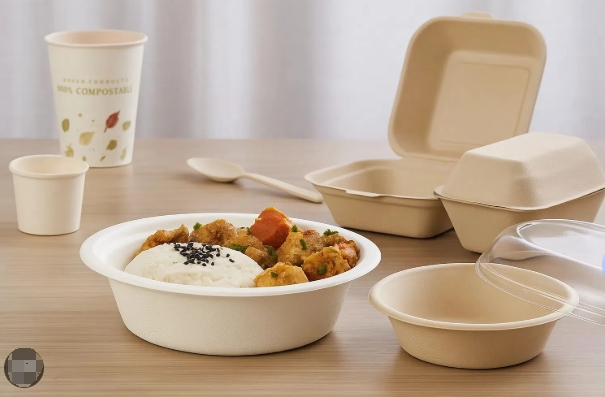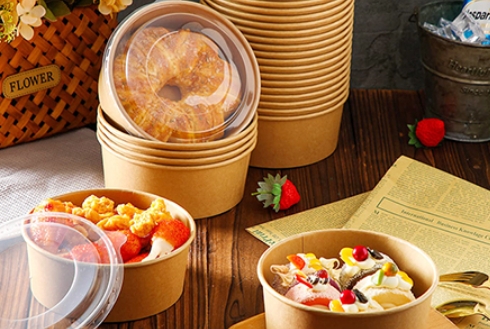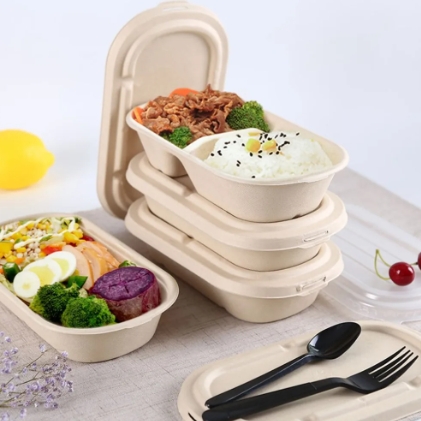
Content Menu
● The Environmental Imperative
>> Reducing Environmental Footprint
>> Supporting a Circular Economy
● Meeting Regulatory Requirements
>> Navigating Bans and Restrictions
>> Future-Proofing Your Business
● Enhancing Customer Experience
>> Meeting Consumer Expectations
>> Health and Safety Benefits
● Boosting Brand Image and Marketability
>> Differentiating Your Business
>> Positive Public Relations
● Operational Advantages
>> Convenience and Versatility
>> Cost-Effectiveness
● Supporting Sustainable Supply Chains
>> Ethical Sourcing
>> Encouraging Industry Change
● Overcoming Common Concerns
>> Performance and Durability
>> Customization and Branding
● Steps to Transition to Degradable Bowl and Lid Sets
>> 1. Assess Your Current Usage
>> 2. Research Suppliers
>> 3. Educate Your Team
>> 4. Communicate with Clients
>> 5. Monitor and Adjust
● Conclusion
● Frequently Asked Questions
>> 1. What materials are commonly used in degradable bowl and lid sets?
>> 2. Are degradable bowls and lids as durable as traditional plastic options?
>> 3. How should degradable serving ware be disposed of after use?
>> 4. Is there a significant cost difference between degradable and traditional serving ware?
>> 5. Can degradable bowls and lids be customized for branding purposes?
In today's dynamic catering industry, businesses are under increasing pressure to deliver exceptional service while also embracing environmentally responsible practices. One of the most significant shifts in recent years is the move away from traditional plastic and non-biodegradable serving ware toward degradable bowl and lid sets. This transition is not just a passing fad—it's a reflection of growing consumer demand for sustainability, health consciousness, and operational efficiency.
This article explores in depth the reasons why degradable bowl and lid sets are the superior choice for catering businesses. From environmental advantages and regulatory compliance to customer appeal and brand enhancement, we'll examine how adopting these products can elevate your catering services and safeguard your business for the future.

The Environmental Imperative
Reducing Environmental Footprint
Catering businesses generate substantial waste, much of which comes from disposable serving ware. Traditional plastic bowls and lids can linger in landfills for centuries, contributing to pollution and harming ecosystems. In contrast, degradable bowl and lid sets are designed to break down naturally, minimizing their environmental impact. By choosing degradable options, caterers can significantly reduce their ecological footprint and contribute to a cleaner, healthier planet.
Supporting a Circular Economy
Degradable bowl and lid sets are often crafted from renewable resources such as plant fibers, cornstarch, or sugarcane bagasse. These materials decompose much more quickly than conventional plastics and support the principles of a circular economy. After use, these products can return to the earth as compost, enriching the soil and completing a sustainable life cycle. This stands in stark contrast to single-use plastics, which remain a persistent environmental challenge.
Meeting Regulatory Requirements
Navigating Bans and Restrictions
Many regions have enacted strict regulations on single-use plastics, with bans and restrictions becoming increasingly common. Catering businesses that continue to use non-degradable serving ware risk facing penalties, reputational damage, and operational disruptions. Degradable bowl and lid sets provide a compliant alternative, ensuring your business can operate smoothly and confidently within the law.
Future-Proofing Your Business
Regulatory landscapes are evolving rapidly, and what is permissible today may be restricted tomorrow. By proactively adopting degradable options, catering businesses can stay ahead of regulatory changes, avoid costly transitions in the future, and position themselves as leaders in sustainability.
Enhancing Customer Experience
Meeting Consumer Expectations
Modern consumers are more environmentally conscious than ever before. They expect the businesses they support to share their values and make responsible choices. Offering degradable bowl and lid sets demonstrates a commitment to sustainability, which can enhance customer satisfaction and loyalty. Clients are more likely to choose caterers who align with their ethical standards, especially for events where environmental impact is a key consideration.
Health and Safety Benefits
Degradable bowls and lids are typically free from harmful chemicals found in some plastics, such as BPA and phthalates. This makes them a safer option for serving food, especially for children, the elderly, and those with sensitivities. By prioritizing the health and well-being of your clients, your catering business can build a reputation for quality and care.
Boosting Brand Image and Marketability
Differentiating Your Business
In a competitive market, standing out is essential. Adopting degradable serving ware can set your catering business apart from competitors who have yet to make the switch. This differentiation can be a powerful marketing tool, attracting eco-conscious clients and opening doors to new business opportunities.
Positive Public Relations
Sustainability initiatives often garner positive media attention and word-of-mouth referrals. By publicizing your use of degradable bowl and lid sets, you can enhance your brand image, attract environmentally minded clients, and build goodwill within your community. This positive reputation can translate into increased bookings and long-term business growth.
Operational Advantages
Convenience and Versatility
Degradable bowl and lid sets are designed for convenience. They are lightweight, stackable, and easy to transport, making them ideal for events of all sizes. Many degradable options are also microwave and freezer safe, offering versatility for a wide range of catering applications.
Cost-Effectiveness
While the initial cost of degradable serving ware may be slightly higher than traditional plastics, the long-term benefits often outweigh the expense. Reduced waste disposal fees, avoidance of regulatory fines, and increased customer loyalty can all contribute to a healthier bottom line. Moreover, as demand for sustainable products grows, prices are becoming more competitive, making degradable options increasingly accessible.
Supporting Sustainable Supply Chains
Ethical Sourcing
Many suppliers of degradable bowls and lids prioritize ethical sourcing and fair labor practices. By choosing these products, catering businesses can support companies that are committed to social and environmental responsibility. This alignment with ethical supply chains further enhances your business's reputation and appeal.
Encouraging Industry Change
Every catering business that adopts degradable serving ware contributes to a larger movement toward sustainability. By creating demand for eco-friendly products, caterers can encourage manufacturers to innovate and expand their sustainable offerings, driving positive change throughout the industry.
Overcoming Common Concerns
Performance and Durability
Some caterers worry that degradable bowls and lids may not perform as well as traditional plastics. However, advances in materials science have led to the development of high-quality degradable options that are sturdy, leak-resistant, and suitable for both hot and cold foods. These products can withstand the rigors of catering events without compromising on quality or presentation.
Customization and Branding
Degradable serving ware can be customized with logos, colors, and designs, allowing catering businesses to maintain their brand identity while making sustainable choices. This customization ensures that your events remain visually appealing and aligned with your brand image.

Steps to Transition to Degradable Bowl and Lid Sets
1. Assess Your Current Usage
Begin by evaluating your current inventory of serving ware. Identify areas where degradable options can be introduced without disrupting operations.
2. Research Suppliers
Look for reputable suppliers that offer high-quality degradable bowl and lid sets. Consider factors such as material composition, certifications, and customer reviews.
3. Educate Your Team
Ensure that your staff understands the benefits of degradable serving ware and how to use and dispose of it properly. Training is key to a smooth transition.
4. Communicate with Clients
Inform your clients about your commitment to sustainability and the advantages of degradable serving ware. Highlight this initiative in your marketing materials and proposals.
5. Monitor and Adjust
Regularly review the performance of your degradable serving ware and solicit feedback from clients and staff. Be prepared to make adjustments as needed to optimize your operations.
Conclusion
Choosing degradable bowl and lid sets for your catering business is more than just an environmental gesture—it is a strategic decision that offers a multitude of benefits. From reducing your ecological footprint and complying with regulations to enhancing customer satisfaction and strengthening your brand, the advantages are clear. By making the switch, you position your business as a leader in sustainability, attract discerning clients, and contribute to a healthier planet. The transition may require some initial investment and adjustment, but the long-term rewards are well worth the effort.

Frequently Asked Questions
1. What materials are commonly used in degradable bowl and lid sets?
Degradable bowl and lid sets are typically made from materials such as plant fibers, cornstarch, sugarcane bagasse, and other renewable resources. These materials are chosen for their ability to break down naturally and return to the environment without leaving harmful residues.
2. Are degradable bowls and lids as durable as traditional plastic options?
Yes, modern degradable bowls and lids are designed to be sturdy and reliable. They can handle both hot and cold foods, and many are leak-resistant and microwave safe, making them suitable for a wide range of catering applications.
3. How should degradable serving ware be disposed of after use?
Degradable serving ware should be disposed of in composting facilities whenever possible. If composting is not available, these products will still break down more quickly in landfills compared to traditional plastics, reducing their environmental impact.
4. Is there a significant cost difference between degradable and traditional serving ware?
While degradable options may have a slightly higher upfront cost, the long-term benefits—such as reduced waste disposal fees, compliance with regulations, and increased customer loyalty—often offset the initial expense. As demand grows, prices continue to become more competitive.
5. Can degradable bowls and lids be customized for branding purposes?
Absolutely. Many suppliers offer customization options, allowing you to add your logo, choose specific colors, or create unique designs. This ensures that your sustainable choices also support your brand identity.

















